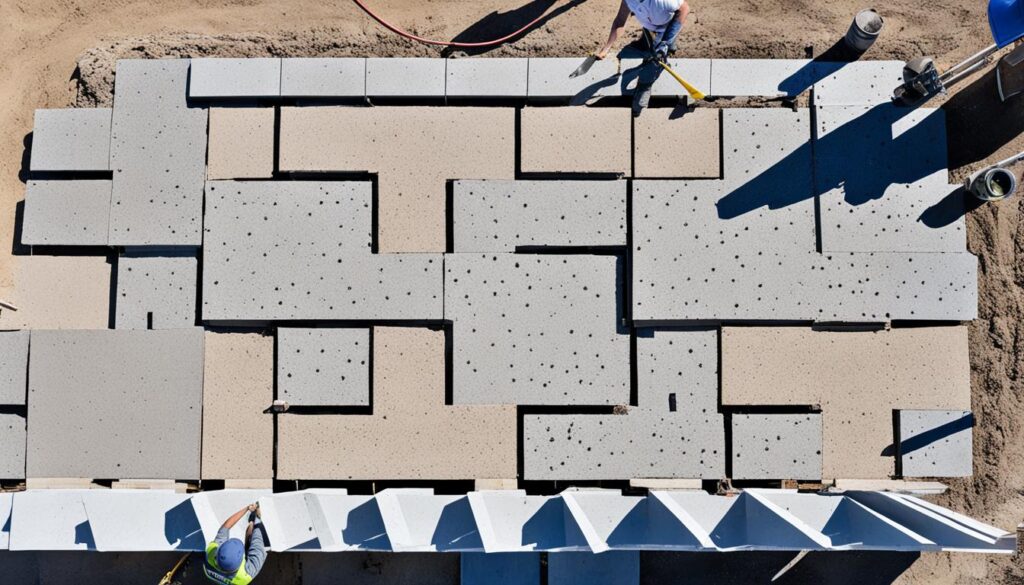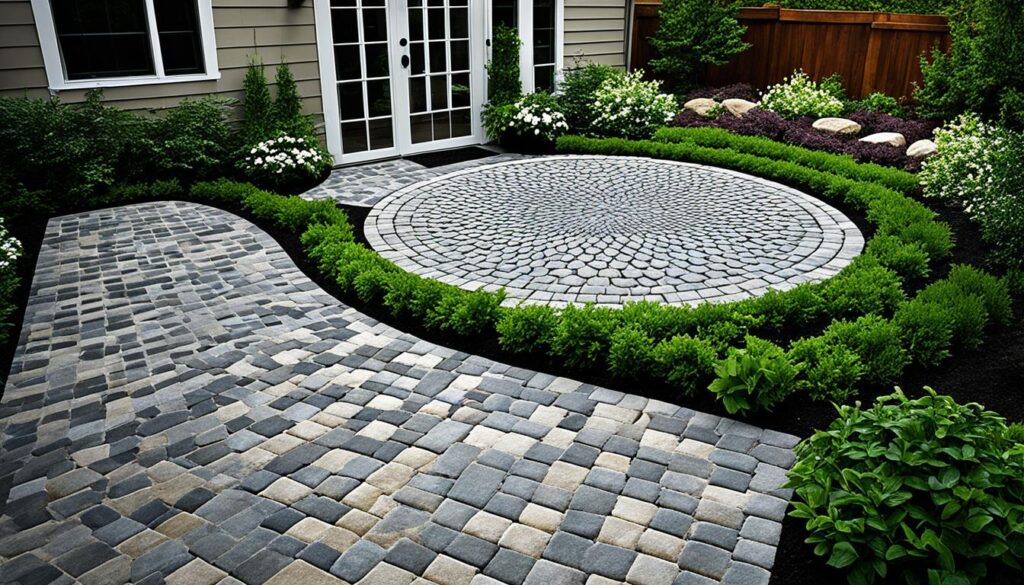
Homeowners now have many choices for making their outdoor spaces look great. Permeable pavers and traditional pavers are top picks for green landscaping. Let’s explore how these options differ and shine in backyard design.
Permeable pavers are now more popular because they help with water management. They let rainwater soak through, which cuts down on runoff and helps recharge groundwater. Traditional pavers, however, are known for their long-lasting look and feel in landscaping.
Both types of pavers bring special benefits to homeowners wanting to improve their outdoor areas. They affect the look and use of your backyard oasis in different ways. Choosing between permeable and traditional pavers can change how your backyard looks and works.
Key Takeaways
- Permeable pavers are great for managing water and green landscaping
- Traditional pavers are known for their classic look and durability
- Both offer many design options for backyard spaces
- More homeowners are choosing eco-friendly hardscaping
- The type of paver you pick affects both the look and use of your backyard
Understanding the Basics: Permeable and Traditional Pavers Defined
Pavers come in two main types: permeable and traditional. Each has its own benefits for backyard design. Let’s look at their key features and differences.
What are Permeable Pavers?
Permeable pavers, known as porous pavement, let water go through or around them. This design helps manage stormwater runoff by letting rainwater soak into the ground. These pavers have wider joints filled with small stones, making spaces for water to flow through.
Characteristics of Traditional Pavers
Traditional pavers are solid pavers that fit together without gaps. They’re often made from concrete, brick, or natural stone. They don’t let water pass through but can be sloped to send runoff to drainage systems.
Key Differences at a Glance
- Water Management: Permeable pavers reduce runoff, while traditional pavers direct it
- Installation: Permeable systems need a special sub-base; traditional pavers use standard base materials
- Maintenance: Permeable pavers need regular cleaning to keep them porous; traditional pavers are easier to maintain
- Cost: Permeable systems might cost more upfront but can save on drainage systems later
Both permeable and traditional pavers are great for outdoor spaces. Your choice depends on your needs, local rules, and how you want your space to look. Read this extraordinary article and broaden your horizons.
Environmental Impact: How Permeable Pavers Benefit Ecosystems
Permeable pavers are changing urban landscapes for the better. They help with sustainable drainage systems and address ecological issues in cities and suburbs.

These pavers let rainwater soak into the ground, unlike regular surfaces that block it. This helps recharge groundwater, which is vital for ecosystems.
In cities, permeable pavers fight the urban heat island effect. They absorb less heat than other materials, making outdoor spaces cooler and reducing building cooling costs.
- Enhances stormwater management
- Reduces runoff and flooding risks
- Decreases strain on municipal drainage systems
Permeable pavers are great at cutting down pollution. As water flows through them, it cleans itself. This means cleaner water in streams and rivers.
Using permeable pavers in city planning makes cities more resilient and green. These materials solve many environmental problems, leading to healthier communities.
Aesthetic Considerations: Design Possibilities with Both Paver Types
Landscaping design offers endless possibilities with paver choices. Permeable and traditional pavers each bring unique looks to outdoor spaces. Let’s look at how each type can make your backyard retreats stunning.
Color and Pattern Options for Permeable Pavers
Permeable pavers come in many colors and patterns, matching any style, from earthy to vibrant. Their interlocking designs and shapes let you create unique layouts, boosting curb appeal and keeping your space functional.

Versatility in Traditional Paver Designs
Traditional pavers come in many textures and finishes. You can choose from smooth, tumbled, or textured surfaces. They can also be laid out in classic patterns like herringbone, basketweave, or running bond, which suits many architectural styles.
Blending Functionality and Style in Backyard Spaces
Using both paver types can make your outdoor spaces unique. Put permeable pavers on walkways and patios. Use traditional pavers for seating areas or fire pit surrounds. This mix looks great and manages water runoff well. With planning, your backyard can be both functional and stylish.
- Mix and match colors for visual interest
- Create borders with contrasting paver types
- Incorporate curves and straight lines for dimension
- Use pavers to define different outdoor zones
Installation Process: Comparing Permeable and Traditional Paver Methods
Installing pavers needs careful planning and execution. The process varies between permeable and traditional pavers, each with its own set of challenges. It’s important to prepare the subbase well for both types to make sure they last long and work well.
Traditional paver installation begins with digging and compacting the soil. Then, a layer of gravel is put down, followed by sand. The pavers are laid on top, and sand is swept into the gaps. This method is good for DIY projects if you have the right guidance.
Installing permeable pavers is more complex. It needs deeper digging and layers of different aggregates. This setup lets water flow through and into the ground. Because it’s so detailed, it’s often best to get professional help for permeable paver installation.
- Excavation depth: Traditional (4-6 inches), Permeable (8-12 inches)
- Base materials: Traditional (gravel, sand), Permeable (various-sized aggregates)
- Joint filling: Traditional (sand), Permeable (small aggregates)
Both types of pavers need regular upkeep. Clean them often, refill the joints with sand or aggregates, and fix any settling. Knowing how to install them, whether by yourself or with a pro, is key to a successful outcome.
Cost Analysis: Initial Investment and Long-Term Value
Planning your backyard makeover means looking at paver pricing closely. Permeable pavers are pricier at first than traditional ones. This is because they need special materials and a certain way of installation for water management.
Even though they cost more at first, permeable pavers can save you money over time. They help manage stormwater, which might cut down on drainage system costs. Traditional pavers might look cheaper initially but could need more repairs because of water damage.
Both types of pavers can increase your property’s value but in different ways. Permeable pavers are good for those who care about the environment and live in places with strict stormwater rules. Traditional pavers, however, have a classic look that never goes out of style. Choose based on your budget, local weather, and what you want for your property’s future.
Yavapai Landscaping Prescott offers free quotations for landscaping and tree services in Prescott and its nearby localities. These include tree removal, trimming, stump grinding, land clearance, storm clean-up, and emergency tree service.
